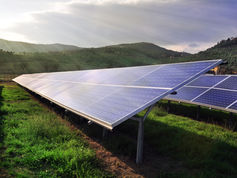South Africa's Farmers Riled as Nuclear Waste Heads Their Way
- Deogracias Kalima
- Sep 18
- 4 min read
As nuclear plants take off in South Africa, farmers dread that high-level, radioactive nuclear waste will be buried on their land in a Nevada-like remote district.
"The government is not being transparent with us," Francois Ko Van, a sheep farmer in the Namaqualand district, a target site, fumes when told that waste will be disposed of in their district from 2030 onward.
Historically, nuclear waste in South Africa was buried in a special pool onsite at Koeberg Nuclear Power Station, the colonial-era reactor that is situated in Cape Town, the country's second most populous city. Koeberg’s total net power output is approximately 1,860 MW, with each of its two units contributing about 930 MW to South Africa’s national power pool.
However, Cape Town has grown rapidly as a city, and therefore, waste must be disposed of far away.
Eskom, South Africa’s state-owned electricity generation and distribution agency, is switching tactics, planning to transport nuclear waste to a central interim storage facility under construction in Namaqualand - 1,500 kilometers away.
Namaqualand – located in the southwestern desert of South Africa - is a critically biodiverse and remote region. It is renowned globally for its indigenous people, diverse flora and fauna, precious minerals, and distinctive sheep meat and wool. And this is where spent nuclear fuel is headed, Ko Van says.
This will also have critical importance for neighboring countries, such as Namibia, as South Africa is the only African country with a nuclear power station. Since 1985, South Africa has buried low-level nuclear waste (old fuel racks, filters, resins, and protective clothing) in steel canisters on site at Koeberg, and high-level waste in a special pool at Koeberg, according to Dan Marokane, the Eskom CEO.
In the past, this has always worked because the reactor didn't have many mechanical breakdowns – and South Africa did not have ‘nasty’ electricity blackouts, being brutally ‘overstretched beyond its lifespan', says Tapuwa Nhachi, an environment management expert.
Something is changing: South Africa is now beset with a severe shortage of electricity as Eskom’s ageing coal power stations break down frequently, resulting in a record 200 days of power cuts in 2023. The reason is that, over the last 20 years, Eskom, the electricity utility, has nearly fallen into bankruptcy, with total debts mounting to $30 billion, underlining a legacy of corrupt mismanagement and a lack of planning, says Nhachi. The operation of Koeberg nuclear power station’s operational life has been labelled a ‘dangerous lifetime extension’ by experts in the past.
With South Africa now scrounging for more electricity to power its economy, 400MW from the construction of new nuclear power stations was authorized in August. The high-level nuclear waste from Koeberg – and from any other nuclear plants that may be built in South Africa – will be taken to a central interim storage facility to be constructed at Vaalputs, Namaqualand, and operations will commence in 2030, says Riedewaan Bakardien, Chief Executive of the National Radioactive Waste Disposal Institute.
‘This is irresponsible. Radioactive nuclear waste cannot co-exist with livestock and crop agriculture,’ counters Jan Palm chairperson of Transvaal Agriculture Union, a national farmers’ collective.
Namaqualand was already water-stressed to its limits, and the storage of nuclear waste poses environmental and human health risks due to radioactive contamination of soil, water, livestock, and the avoidance of produce from the region by consumers.
In the radius of the Vaalputs District where the nuclear waste will be buried, there are 200 farms involved in cattle, goats, and sheep rearing. Thirty percent are slaughtered locally, with the rest distributed nationwide – and exported abroad.
"We may not see radiation, but the biosafety impact will be immense," Palm says. "The likelihood of radiation may be low, but the impact can be huge," Palm adds.
What upsets farmers is that they are already seeing construction vehicles and equipment arriving, and they have not been adequately consulted. In South Africa, a country with a fast-deteriorating road network due to years of neglect, any ‘accident of trucks carrying nuclear fuel waste could cause catastrophe’, Palm adds.
Authorities allay fears, saying that between 50 and 200 years from now, the nuclear waste will be moved to a final disposal site several hundred meters underground. ‘It is essentially a mine for now,' Bakardien says, insisting that the International Atomic Energy Agency is ‘strictly’ monitoring the process. Nuclear waste decays rapidly in the first ten years, although it takes approximately 100,000 years to return to the same level of radiation as uranium in its natural state.

Princess Mthombeni, founder of Africa4Nuclear, a group that lobbies for nuclear energy as a solution to Africa’s electricity shortages, agrees with authorities that nuclear waste can be safely stored in farming areas. In the UK, for example, the Low-Level Waste Repository is situated in the Lake District, a UNESCO World Heritage site and a popular destination for tourism and farming.
“The Champagne region of France hosts some of the world’s most iconic vineyards, but has nuclear infrastructure near it,” Mthombeni says.
Farmers would have believed the science if South Africa’s government was not ‘hopelessly corrupt’ to the extent that ‘neglected underground gas networks are exploding’, Ko Van, the farmer says, pointing to a tragedy that killed one and injured dozens when decades-old state gas power lines suddenly sank an entire street in Johannesburg, in 2023. ‘We definitely don’t trust them with more sophisticated power fuels like nuclear. '













Comments